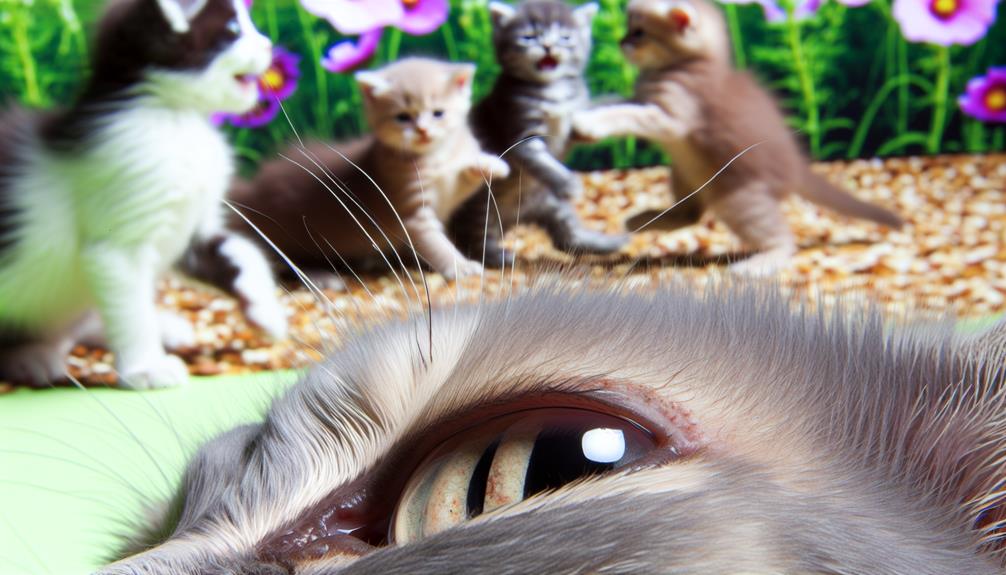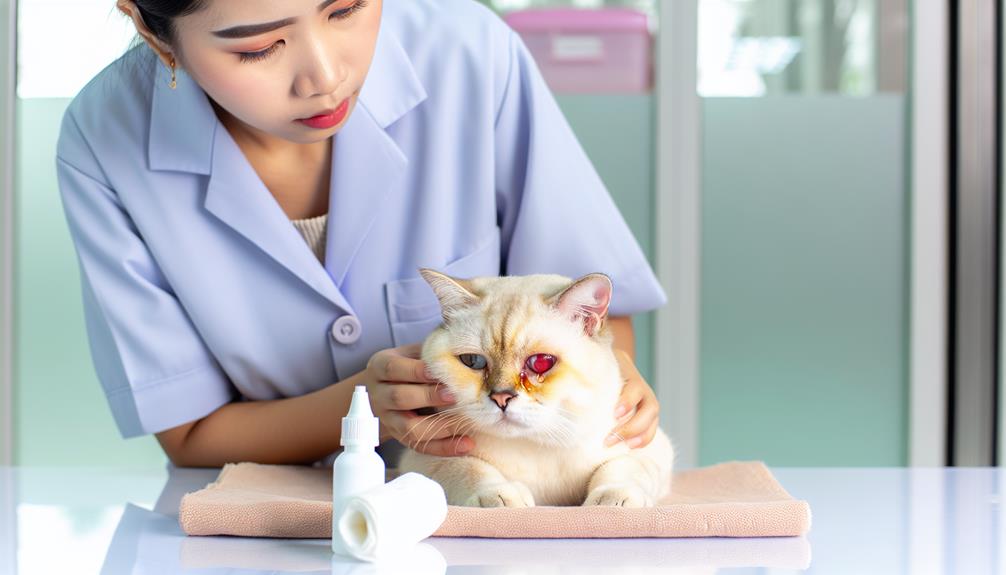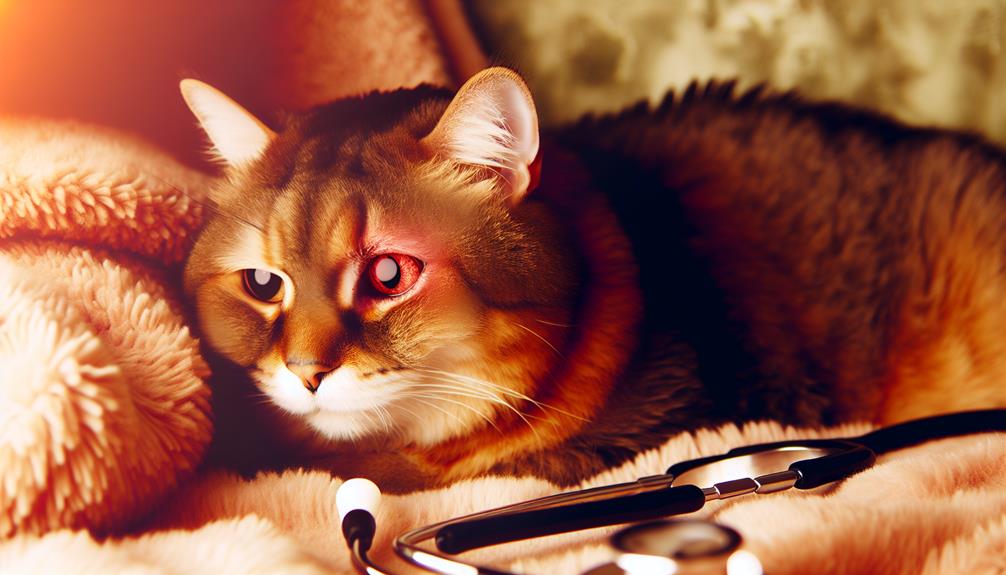You might be wondering if cats can get pink eye, and the short answer is yes. Just like humans, cats can suffer from conjunctivitis, which can make their eyes sore and uncomfortable. You'll often notice symptoms like eye discharge, redness, and excessive tearing. But what actually causes this condition in cats? Is it something you can prevent, or do you need to rush to the vet at the first sign of trouble? Understanding the common culprits and knowing when to seek professional help could make all the difference for your feline friend.
What Is Pink Eye?
Pink eye, clinically known as conjunctivitis, refers to the inflammation of the conjunctiva—the transparent membrane lining the eyelid and covering the white part of the eyeball. In the context of feline eye care, understanding the types of conjunctivitis is essential for proper diagnosis and treatment.
Conjunctivitis in cats can be classified into three primary types: infectious, non-infectious, and allergic. Infectious conjunctivitis is often caused by viral or bacterial pathogens. The feline herpesvirus (FHV-1) is a common culprit, frequently leading to recurrent outbreaks. Bacterial infections, often secondary to viral infections, can exacerbate the inflammation. Non-infectious conjunctivitis, on the other hand, may result from physical irritants such as foreign bodies, trauma, or exposure to chemicals. Allergic conjunctivitis is less common in cats compared to humans but can occur due to environmental allergens like pollen, dust, or mold.
To effectively manage conjunctivitis in cats, you need a thorough approach to feline eye care. First, accurately identifying the type of conjunctivitis is essential. This often involves a detailed clinical examination, cytology, and possibly PCR testing for viral DNA. Once the type is determined, treatment can be tailored accordingly. For infectious conjunctivitis, antiviral medications or antibiotics may be prescribed. Non-infectious types might require removal of the irritant and supportive care, including lubrication and anti-inflammatory medications. Allergic conjunctivitis management often focuses on minimizing exposure to allergens and may include antihistamines.
Symptoms in Cats
Recognizing the symptoms of conjunctivitis in cats is essential for timely and effective intervention. When your feline companion is experiencing this condition, you'll often notice a variety of clinical signs that can help you identify it early. One of the primary indicators is eye discharge, which can vary in color from clear to yellowish or green, indicating the presence of an infection.
Symptoms Table
| Symptom | Description | Potential Causes |
|---|---|---|
| Eye Discharge | Clear, yellow, or green secretion | Infection, feline allergies |
| Redness | Inflammation of the conjunctiva | Irritants, infections |
| Swelling | Puffiness around the eyes | Allergic reactions, trauma |
| Squinting | Partially closed eyelids | Pain, discomfort |
| Excessive Tearing | Watery eyes | Blocked tear ducts, irritants |
The eye discharge accompanying conjunctivitis is often one of the first symptoms you'll see. If the discharge is clear, it's more likely due to feline allergies or a mild irritant. However, if it turns yellow or green, it's a strong indication of a bacterial or viral infection.
Redness and swelling of the conjunctiva are other hallmark symptoms. These signs reflect the inflammatory process, suggesting the conjunctiva is irritated or infected. Your cat might also exhibit squinting or partial closure of the eyelids, indicating discomfort or pain.
Excessive tearing is another symptom to watch for. While some tearing can be normal, particularly in certain breeds, an increase may signal an underlying issue such as blocked tear ducts or exposure to irritants.
Common Causes

When it comes to identifying the common causes of conjunctivitis in cats, a thorough understanding is vital. Conjunctivitis, often referred to as "pink eye," can result from various etiologies, most significantly bacterial infections and allergic reactions. Recognizing these causes is fundamental to addressing your cat's condition effectively.
Bacterial infections are a prevalent cause of conjunctivitis in felines. Pathogens such as Chlamydia felis and Mycoplasma spp. frequently infect the conjunctival membrane, leading to inflammation and discharge. These bacteria are highly contagious and can spread rapidly in multi-cat households or shelters. If your cat is exposed to these bacterial agents, you'll notice symptoms like redness, swelling, and ocular discharge, which may be either serous or purulent. Timely intervention with appropriate antibiotics, as prescribed by a veterinarian, is essential to mitigate these infections.
Allergic reactions, too, are a significant cause of conjunctivitis in cats. Cats can develop hypersensitivity to various environmental allergens, including pollen, dust mites, and mold spores. When an allergic reaction occurs, the immune system releases histamines, causing the conjunctival blood vessels to dilate and leading to symptoms such as itching, redness, and watery discharge. Managing allergic conjunctivitis involves identifying and minimizing exposure to the offending allergens and possibly administering antihistamines or corticosteroids under veterinary guidance.
Understanding these common causes—bacterial infections and allergic reactions—enables you to take informed steps towards alleviating your cat's conjunctivitis. While there's more to explore regarding diagnosis and treatment, recognizing these primary causes is the first step in ensuring your feline companion's ocular health.
Diagnosis Methods
Accurately diagnosing conjunctivitis in cats is paramount to providing effective treatment. The process begins with an extensive veterinary examination to ascertain the underlying cause of the condition. Diagnostic techniques employed by veterinarians are thorough and multi-faceted, guaranteeing that all potential factors are considered.
During the initial examination, your vet will perform a detailed visual inspection of your cat's eyes. This includes checking for redness, swelling, discharge, and any signs of discomfort. They'll also assess the overall health of the eyelids and conjunctiva. Fluorescein staining is a common diagnostic technique used to detect corneal ulcers or abrasions, which can sometimes be a concurrent issue.
Next, your vet may employ Schirmer tear tests to measure tear production. Insufficient tear production can indicate dry eye syndrome (keratoconjunctivitis sicca), which could be a contributing factor to the conjunctivitis. Cytology, the microscopic examination of cells collected via swabbing, helps identify the presence of bacteria, fungi, or parasites within the conjunctival tissue.
In certain cases, advanced diagnostic techniques such as polymerase chain reaction (PCR) testing may be necessary. PCR tests are highly sensitive and can detect specific viral or bacterial DNA, making it possible to identify pathogens like feline herpesvirus or Chlamydia felis. Blood tests might also be performed to check for systemic infections or immune-related conditions that could be manifesting in the eyes.
Your vet's thorough approach guarantees that the diagnosis is accurate, guiding appropriate and effective intervention. By understanding the specific cause of your cat's conjunctivitis, you'll be better equipped to address the condition and restore your pet's ocular health.
Treatment Options

Treating conjunctivitis in cats often necessitates a multi-modal approach that targets both the symptoms and the underlying cause. To effectively manage feline conjunctivitis, you'll need to combine veterinary care with appropriate home remedies. Here's a detailed guide on treatment options:
- Veterinary Care: The cornerstone of treating conjunctivitis in cats is professional veterinary care. Your vet may prescribe antibiotic or antiviral eye drops depending on the etiology—bacterial or viral. In addition, anti-inflammatory medications can help reduce ocular discomfort and swelling. It's essential to follow the prescribed treatment regimen strictly to avoid recurrence or complications.
- Home Remedies: While veterinary care is indispensable, certain home remedies can complement the treatment. Gently cleaning your cat's eyes with a saline solution can help remove discharge and keep the area clean. Compresses soaked in chamomile tea can provide soothing relief. However, always consult your vet before using any home remedies to confirm they won't interfere with medical treatments.
- Hygiene and Environmental Control: Maintaining a clean environment can greatly aid in the recovery process. Regularly wash your cat's bedding, toys, and feeding bowls to minimize the risk of reinfection. Isolating the affected cat from other pets can also prevent the spread of infectious conjunctivitis.
Prevention Tips
Preventing conjunctivitis in cats requires a proactive approach that focuses on minimizing exposure to potential irritants and pathogens. First and foremost, maintaining ideal cat hygiene is vital. Regularly clean your cat's living environment, including bedding, litter boxes, and feeding areas, to reduce the risk of bacterial and viral infections. Additionally, make certain that your cat is groomed regularly, as matted fur around the eyes can harbor pathogens and irritants.
Eye care plays a notable role in preventing conjunctivitis. Inspect your cat's eyes daily for any signs of redness, swelling, or discharge. If you notice any abnormal symptoms, consult your veterinarian promptly. To further support eye health, you can gently clean the area around your cat's eyes using a damp, soft cloth or a veterinary-approved eye wipe. This removes debris and potential irritants that could lead to infection.
Vaccination is another essential preventive measure. Make certain your cat is up-to-date on all important vaccinations, particularly those that protect against feline herpesvirus and calicivirus, common pathogens associated with conjunctivitis. Regular veterinary check-ups can help detect early signs of eye issues and guarantee timely intervention.
Minimize your cat's exposure to other animals that might be infected. If you introduce a new cat into your home, quarantine them until a veterinarian confirms they are disease-free. Avoid sharing toys, food bowls, or other personal items between cats, as these can be vectors for pathogens.
Lastly, bolster your cat's immune system through a balanced diet rich in essential nutrients. A strong immune system can naturally combat infections more effectively, reducing the likelihood of conjunctivitis. Implementing these evidence-based practices will greatly decrease the risk of your cat developing pink eye.
Conclusion
So, next time your cat gives you the stink eye, it might not just be their attitude—pink eye could be the culprit. Recognizing the symptoms and seeking timely veterinary care guarantees your feline friend doesn't have to squint their way through life. Remember, while your cat may enjoy pretending they're above it all, their eye health is quite serious. With the right treatment, they'll be back to their aloof, judgmental selves in no time.
